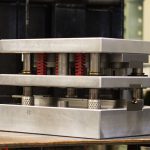 There is a cold forming process that is called metal stamping in which a press is used to conform sheet-metal into different shapes and sizes. They will utilize flat sheet-metal, called blanks, which are fed into the machine that will be reconfigured using a tool and die. There are many production facilities across the country that use these metal fabricators that can create these sections and pieces, utilizing pressure that can shear and shape the material into components or products that are needed to be a certain configuration.
There is a cold forming process that is called metal stamping in which a press is used to conform sheet-metal into different shapes and sizes. They will utilize flat sheet-metal, called blanks, which are fed into the machine that will be reconfigured using a tool and die. There are many production facilities across the country that use these metal fabricators that can create these sections and pieces, utilizing pressure that can shear and shape the material into components or products that are needed to be a certain configuration.
In this article, we will show you the different steps of the metal stamping process that you need to know, and also present types of stamping presses that are often used, many of which are similar to other fabrication processes, plus we will go over the different types of stamping procedures and the applications that are associated with them.
An Overview Of Metal Stamping
Metal pressing, otherwise known as metal stamping, is a process by which identical metal components can be formed at a very fast rate. These stamping operations can be done for long periods of time, or short periods of time, creating metal that can be formed in a specific way through techniques and processes such as:
• Punching
• Blanking
• Embossing
• Coining
• Bending
• Flanging
Blanking and punching is also referred to how the material is cut into very specific forms. These are also called punching operations where scrap pieces of metal are effectively cut out, leaving a hole in the original piece. If you are using blanking, this is different because it takes the original workpiece and removes that component from the desired workpiece instead.
There is another process called embossing in which the metal will be recessed, or raised up, in the sheet-metal, and this is done by pressing that material against a die that will have a particular shape, or it also can be done by passing the material through what is called a roller die.
Another technique is called coining in which they will use a bending process where the metal will be stamped in between a press or punch and the die. The punch tip is designed to penetrate the metal, creating a very accurate set of repeatable bends. This deep penetration is going to limit the amount of internal stress on the piece of metal, and this will result in no spring back effects.
If this is a process that involves bending, this is a more general technique when forming different types of metal into shaped profiles. The bending process can result in ID formation which is the result of stresses that go beyond the yield point, but are far below the tensile strength of the metal. When bending does occur, this is almost always around a single axis.
Flanging is a process where a flare or flange is placed on the piece of metal that is going to be used with a flanging machine, metal presses, or a metal dive.
Metal stamping machines are not just designed to stamp the material; they can just as easily shape the metal by cutting, punching, or casting the sheets of metal easily. These are typically done using a very controlled computerized system called a CNC which will offer the highest amount of precision and repeatability for each piece. There is another method called EDM or electrical discharge machining which also uses CAD or computer-aided design software which can help improve overall accuracy. When looking at the various machines that are designed for tooling, the different dies that are used for stamping are numerous. Whether you are looking at compound, forming, progressive, or carbide tooling, each of these will be specific to your exact stamping needs.
Progressive dies can be utilized in order to create several different pieces on a single piece at the same time.





